

 |
 |
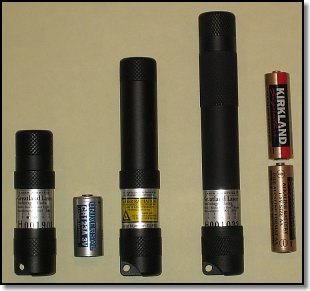 When I first saw Greatland Laser's prototype for their "Rescue Laser Flare" in May of 1999 I was greatly impressed with the concept (see original story from our SAR The Americas 1999 report). It seemed to have incredible potential as a nighttime signaling device. During
the intervening years I have played with a succession of prototypes and offered my feedback and suggestions to Greatland Laser.� In late in 2001 I received the first production samples. Since then there have been a number of improvements made to the design and construction, and additional models added. This review was updated in December 2006 with current information on the available models and performance.
When I first saw Greatland Laser's prototype for their "Rescue Laser Flare" in May of 1999 I was greatly impressed with the concept (see original story from our SAR The Americas 1999 report). It seemed to have incredible potential as a nighttime signaling device. During
the intervening years I have played with a succession of prototypes and offered my feedback and suggestions to Greatland Laser.� In late in 2001 I received the first production samples. Since then there have been a number of improvements made to the design and construction, and additional models added. This review was updated in December 2006 with current information on the available models and performance.
There are three models of the Rescue Laser, two which emit a red laser, one which emits a green laser. Functionally, they all operate the same way, the primary difference being size and the performance difference between the red and green laser. I'll review the functional similarities first.
First, the concept. The basic idea is to modify a laser beam using a lens of sorts so that it projects a line rather than the pinpoint light source we normally associate with a laser.� The theory being that the expanding vertical line would cover a wide swath so that it would greatly increase the odds of being seen as a survivor scans a target or the horizon. The flash of the laser light is extremely distinctive and should be more attention getting than a traditional flashlight used under similar circumstances. Another use would be for Search and Rescue (SAR) forces to use a similar tool to cover more ground or water than could be done with the relatively limited area lit by a searchlight, with any retro-reflective material being picked up in the beam and reflecting back the laser light source and the searchers. We have tested this to well over a mile with less than an inch square of retro-reflective material.
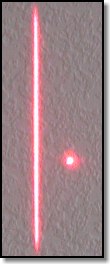 The red laser beam exits the aperture with a 4 degree spread. This gives a line of roughly 9 inches (22.8 cm) at 10 feet (3.05 m), as measured in the photo above compared to the typical pinpoint laser pointer beam next to it. Plugging the beam angle into a formula, this results in a beam 738 ft. (225 m) long at 2 miles (3.2 km) and 3,690 ft. (1,125 m) long at 10 miles (16 km). The green beam has about a 2.5 degree spread, giving a 1,500 ft. (457 m) long line at 10 miles (16 km).
The red laser beam exits the aperture with a 4 degree spread. This gives a line of roughly 9 inches (22.8 cm) at 10 feet (3.05 m), as measured in the photo above compared to the typical pinpoint laser pointer beam next to it. Plugging the beam angle into a formula, this results in a beam 738 ft. (225 m) long at 2 miles (3.2 km) and 3,690 ft. (1,125 m) long at 10 miles (16 km). The green beam has about a 2.5 degree spread, giving a 1,500 ft. (457 m) long line at 10 miles (16 km).
The theory works well in the real world, with a few caveats. In many respects it works just like a signal mirror. You do need to aim the laser at your target (unless just slowly scanning the horizon in hopes someone will see it). With the red laser, the only practical ways to do this is to sight down the tubular body using the other hand as a "gun sight" in exactly the same way you aim a signal mirror that does not have a retro-reflective aimer (see the accompanying illustration). The green laser is usually far easier to aim and usually it can be done one-handed, one of its not insignificant advantages. Our eyes are much more sensitive to the green light such that you are able to pick up the reflections of the laser on every bit of dust, water droplet, etc. in the air. You can physically see the green line, which you then just aim at the target. Since it would be extremely rare for there not to be something in the air to reflect that light, it's almost a sure thing and has never failed in all our testing over the years.
While it was initially thought that the long line of the laser as it expands towards the target would make aiming unnecessary, just point it in the general direct and scan the line across the target, the results using this method were less than satisfactory. It will work if you scan slowly, but it isn't efficient. I should note that we developed the aiming concept during our initial ground to air testing. Credit is due Wil Milan who discovered that aiming made the laser far more effective.
As with a mirror or a flashlight beam, it's virtually impossible to hold the laser beam directly on a distant target, and that wouldn't be much of a signal or attention getting in any case. The idea is to move it so that you "flash" the target as the beam and the searchers' eyes intersect for that brief moment. While the laser is bright, it is neither as bright as the sun, nor is the beam even close to as wide as the sun reflecting off a mirror or the light beam from a flashlight. The somewhat non-intuitive result is that if you move the laser too quickly across a searcher's field of view, they may well not see it. The "secret" is to move is very slowly, nor rapidly like you are taught to move a mirror or flashlight when signaling with them. In our experience, a rate of about 5 degrees a second is about perfect. This is pretty darn slow and takes some getting used to and some mental discipline to maintain this slow scan rate.
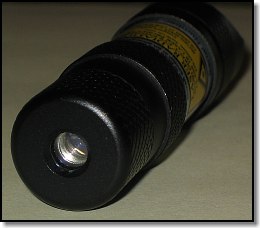 We have conducted a number of tests over the years, both ground to ground and ground to air. These are line of sight devices, which in the case of ground to ground signaling means that it is limited in part by the curvature of the earth (approximately 6.5 miles (10.5 km) assuming both persons have eye levels at 5.5 ft. (1.68 m) above the level ground). So, unless you or the target are on a hill or mountain, you'll never approach maximum range. So, for testing purposes, our ground to air tests provide the best indication of maximum available performance.
We have conducted a number of tests over the years, both ground to ground and ground to air. These are line of sight devices, which in the case of ground to ground signaling means that it is limited in part by the curvature of the earth (approximately 6.5 miles (10.5 km) assuming both persons have eye levels at 5.5 ft. (1.68 m) above the level ground). So, unless you or the target are on a hill or mountain, you'll never approach maximum range. So, for testing purposes, our ground to air tests provide the best indication of maximum available performance.
For our primary ground to air tests there was a bright full moon (timing is everything) and scattered low clouds. Visibility� was about 40 miles (64 km) in very light dust/haze (aviation meteorological visibility at night is the distance you can see a prominent lighted object). We were also equipped with the latest Generation 3 military night vision goggles (NVGs).
As we have always done in our ground to air distress signaling testing, our test protocol is to have the observing aircraft fly a track back and forth perpendicular to the directed signal at set distances from the ground team. The directed signal is aimed in a set direction to ensure we get accurate and repeatable results. GPS has made this testing far easier and more accurate. After each test sequence, the aircraft moves further away to determine maximum range. For weaker devices close in, we move a mile at a time, at greater distances we move two or three miles, or more, at a time, making adjustments to the interval based on experience with the devices being tested.
Please note that the maximum rangees that follow were predicated on knowing where to look as the lights were very dim at this maximum. This may be applicable in a search where they are looking for you in a particular area. If you are trying to attract attention from a passing aircraft, useful range would be about one half the maximum in most circumstances. Fog or similar conditons will significantly adversely affect the range, but in our experience the laser penetrates fog far better than a flashlight or strobe.
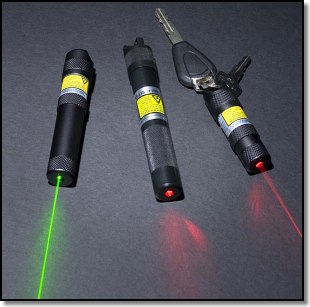 In some of the testing, we compared the laser flares with flashlights and strobes. When using flashlights, they aimed them at us in the same manner as the Rescue Lasers. One very interesting data point was that a 2 x 3-inch glass mil-spec signal mirror was visible three miles (4.8 km) out with a full moon almost directly overhead.� The single LED flashlights were visible at three miles (4.8 km) to four miles (6.4 km).�The white LEDs tested were earlier generation LEDs than the current generation white LEDs, as used in the Doug Ritter Photon Freedom for example, so I'd expect even better range today. Using the slow flashing/strobing mode, it was easier to locate, more readily noticeable than a steady light, but absolute range was the same.
In some of the testing, we compared the laser flares with flashlights and strobes. When using flashlights, they aimed them at us in the same manner as the Rescue Lasers. One very interesting data point was that a 2 x 3-inch glass mil-spec signal mirror was visible three miles (4.8 km) out with a full moon almost directly overhead.� The single LED flashlights were visible at three miles (4.8 km) to four miles (6.4 km).�The white LEDs tested were earlier generation LEDs than the current generation white LEDs, as used in the Doug Ritter Photon Freedom for example, so I'd expect even better range today. Using the slow flashing/strobing mode, it was easier to locate, more readily noticeable than a steady light, but absolute range was the same.
A Mini-Mag (2 x AAA and halogen bulb) gave out at six miles (9.6 km), a 2 x AA at 12 (19.3 km), which pretty much matched our previous�testing experiences. Pelican's MityLite 1 x AAA with a krypton bulb maxed out at 9 miles (14.5 km), the 2 x AAA at 12 miles (19.3 km), and the 2 x AA Pelican was visible out to 15 miles 924.1 km). A SureFire 6P reached out 25 miles (40.2 km).� Generation III NVGs typically add 20%-50% to these numbers. Obviously, a flashlight is an effective distress signaling device, but its lack of distinctiveness is a notable drawback, and in the case of most higher powered lights, they also tend to have a relatively limited run time at maximum power, particularly those with incandescent bulbs which may be less than an hour.
This testing was conducted prior to the introduction of the Luxeon higher powered LEDs, but you can probably extrapolate based on the relative lumen output, but bear in mind that a diffuse source is going to have shorter range than a focused beam. Someday when we're flush with money, if that ever occurs, we'd like to update this testing.
As we got further away than 20 miles (32 km), the ground team required their NVGs to locate our aircraft's strobe in order to sight the lights and Rescue Lasers on us.� Otherwise, we were unable to see anything from them on a consistant basis.� The red Rescue Laser was visible with the naked eye out to 22 miles (35.4 km), with NVGs out to 28 miles (45 km).
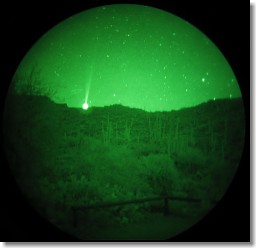 The green laser was going strong with the naked eye at 30 miles (48 km), which is all we had time and resources to test.� In fact, the green laser was so easy to see and so distinctive that we used the green laser for locating purposes to identify the location of ground team at the extreme distances when we lost the location after a course reversal. It was immediately noticeable.�While a prototype green laser we tested early on was not visible with NVGs, the production model currently available is clearly visible with NVGs (as shown in the image which does not show the flash as that would appear as simply a bright green screen)
The green laser was going strong with the naked eye at 30 miles (48 km), which is all we had time and resources to test.� In fact, the green laser was so easy to see and so distinctive that we used the green laser for locating purposes to identify the location of ground team at the extreme distances when we lost the location after a course reversal. It was immediately noticeable.�While a prototype green laser we tested early on was not visible with NVGs, the production model currently available is clearly visible with NVGs (as shown in the image which does not show the flash as that would appear as simply a bright green screen)
We did some minimal experiments in bright daylight, enough to reach the conclusion that both red and green Laser Flares are pretty much ineffective if the bright sun or if the sun is in your eyes to any significant degree and only minimally effective in overcast conditions with range reduced by about 80%-90%. The green Rescue Laser is by far more effective than the red in overcast conditions, as you might expect.�
Greatland Laser originally included a piece of self-adhesive retro-reflective material and instructions for how to use it to learn how best to operate the device.�Since the use of the device is not necessarily intuitive, by using the retro-reflective material it is easy to see how critical it is to move the laser very slowly when scanning a target. Unfortunately, they no longer include this retro-reflective target, nor do they emphasize practicing. I believe that such training is of great value, but the good news is that there's lost of sources of retro-reflective material out there, from road signs to taillights on automobiles, so there's nothing to prevent you from practicing.
The flash of the laser light is definitely distinctive and not likely to be confused with anything else, like a conventional flashlight or strobe may be.� It is perceived as a brilliant flash of light similar to, but not exactly like that from a signal mirror, bright red or green in color. It will surely be more likely to attract attention of passersby, on the ground or in the air. In any area with other white light sources, it also stands out. We're not sure the distinctive flash adds much for searchers specifically looking for a survivor at night in a dark wilderness area or empty ocean where any light source will likely be investigated, but it certainly is more distinctive in any case.
I am often asked about the safety and legality of aiming a Rescue Laser at aircraft after the hysteria surrounding this subject that started a couple years ago. First off, let's address safety. These are FCC approved class IIIa eye-safe laser devices designed for consumer use. The alleged problems were caused by much higher powered lasers that are not eye-safe. So, there's no way you are going to injure a pilot's eyesight with a flash of the Rescue Laser. While the flash is plenty noticeable, it is not in any way blinding, and is much less so than a signal mirror flash at relatively close range, so it also doesn't create a safety of flight issue. On a positive note, all that publicity and hysteria ensures that pilots will likely take notice and report any laser flashes they see promptly, even if they do not recognize it as a distress signall, per se.
As far as the legal issue, if you are in a distress situation, it is a perfectly appropriate means to signal distress. Beyond that, there's federal legislation introduced (HR 1400) to specifically exempt laser distress signaling devices, so eventually there will not even be a question in this regard.
All the current production Rescue Lasers have tubular aluminum bodies with a rotating tail cap switch. We like switches such as this as they are not easily inadvertently switched on in storage. The body has light knurling for a better grip, but there are no flat surfaces, so it will roll off any non-level surface. The body and cap are Type III hard coat anodized black. The coating is tough, but we have never been big fans of black survival gear (except for military use); it's too easily lost. You may want to either affix some bright tape to the body or a brightly colored lanyard.
There is a red soft plastic cap that slips over the aperture end, but there's nothing to attach it to the Rescue Laser and they have been known to disappear. The cap is essential to keep the aperture lens clean when you carry the Rescue Laser in a pocket or elsewhere that it might collect dust and gunk which are not that easy to clean out of the small recess that the lens sits in.
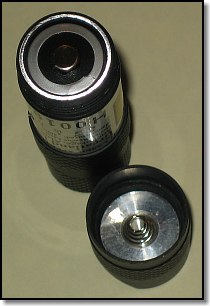 The tail cap incorporates a 1/8 in. (3.2 mm) lanyard hole. This is too small to thread a piece of parachute cord through or to attach a clip. I add a small split ring to mine to make it easy to attach a lanyard in the field.
The tail cap incorporates a 1/8 in. (3.2 mm) lanyard hole. This is too small to thread a piece of parachute cord through or to attach a clip. I add a small split ring to mine to make it easy to attach a lanyard in the field.
The Rescue Lasers are rated waterproof to a depth of 80 feet (24 m) and we found no leakage at a depth of 8 ft., the limit of our test apparatus. We've abused our sample Rescue Lasers pretty mercilessly over the years and they have withstood everything we've thrown at them, or vice versa as the case may be.
One peculiarity of the Rescue Lasers is that unlike a typical flashlight that most everyone is used to, where the positive end is "down" and is located at the head of the light, the positive end is "up" in these. Wile the instructions make this clear, there is nothing on the Rescue Laser itself noting this unconventional arrangement.�The good news is that inserting the battery(ies) the wrong way will not damage the Rescue Laser, it just won't work. However, I really would prefer that the battery polarity was permanently marked on the device in some manner.
The Rescue Lasers come with a limited lifetime warranty.
All the Rescue Lasers are 7/8 in. (22 mm) in diameter. There are two sizes of red Rescue Lasers. The smallest, the Rescue Laser Light, is 3.125 inches (79 mm)long and weighs 2.2 oz. (62 g) (all weights with battery(ies)). It has a rated run time of 40 hours on its single lithium 123-cell and in our tests exceeded that by about 10%. MSRP for the Rescue Laser Light is $89.95 (all pricing as of 12/2006).
The Magnum Rescue Laser Flare is 6 inches (152 mm) long and is powered by a pair of AA-cells. It weighs in at 4.7 oz. (133g). It comes with a pair of alkaline batteries, but I'd suggest replacing them with lithium AA-cells because of their longer shelf life, up to 10 years. Run time is rated at 72 hours with the alkalines, and that is plenty conservative. We got over 95 hours using lithium cells. MSRP for the Magnum Rescue Laser Flare is $99.
The Green Rescue Laser Flare is 4.875 inches (124 mm) long and weighs 3.3 oz. (94 g). It is powered by a single lithium 123-cell with a run time of five hours. In testing it exceeded that by at least 10%. Greatland Laser claims range of up to 30 miles, three miles in daylight. MSRP for the Green Rescue Laser Flare is $249.95. This is the one selected for use by the U.S. military.
Our most important conclusion, beyond that the Rescue Lasers work as advertised, is that the concept of just scanning towards an aircraft without sighting appears to be considerably less effective in practice than in theory. Sighting is essential and the current instructions emphasize that.
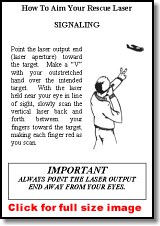 The instructions originally came printed on a waterproof tag attached to the Rescue Laser (see image to right), but for some reason Greatland Laser stopped doing that for a period. I'm of the opinion that it was and still is a good idea. There's no guarantee that the end user has read the instructions. While turning on the Rescue Laser is easy enough to figure out, the aiming and scanning is not intuitive at all.
The instructions originally came printed on a waterproof tag attached to the Rescue Laser (see image to right), but for some reason Greatland Laser stopped doing that for a period. I'm of the opinion that it was and still is a good idea. There's no guarantee that the end user has read the instructions. While turning on the Rescue Laser is easy enough to figure out, the aiming and scanning is not intuitive at all.
In my own Aviator Survival Paks and the custom survival kits and vests I put together for clients, I do include an instruction tag which I've developed myself, using their illustration. This tag also includes directions for replacing the batteries and the unconventional battery polarity of the device. Again, I'd prefer this was marked permanently on the Rescue Laser. I was told by Greatland Laser while finalizing this article that they intend to start providing a waterproof instruction tag again, which move I applaud.
Greatland Laser's claims of�"up to 10 miles" (16 km) visibility seem reasonably conservative, based on our tests. Particularly in the case of the Green Rescue Laser Flare, our experience suggests they are very conservative.
Using the Rescue Laser to locate equipment or people marked with retro-reflective tape or material does work well. If you're going to carry a Rescue Laser, you might as well make sure everything important is so marked. It's not expensive and it could be a life saver, particularly in a marine environment.
The Rescue Laser Flare advantages are small size, duration, robustness in adverse environments and resistance to abuse, potential range for size when aimed and scanned properly, and especially the distinctiveness of the signal.� A conventional flashlight is reasonably effective when trying to signal in situations when Search and Rescue is looking for you and has a good idea where to look. However, if trying to attract attention or reach out beyond visual range, the flashlight simply doesn't cut it, while the Rescue Laser, especially the Green Rescue Laser, excels. It is this ability to attract attention from passersby and passing aircraft especially that separate it from other visual distress signaling devices and especially from a flashlight.
Compared to traditional handheld pyrotechnic devices (flares), it has the very significant advantage of much longer duration, as well as being compact and lots safer. With lithium battery power, the storage life is two to three times that of most pyrotechnics and there's no disposal problems like there is with pyrotechnics. Particularly in the case of the more affordable red Rescue Lasers, this can also mean they are much more economical, even more so if you compare the cost to the much more effective SOLAS flares as opposed to the less capable USCG approved flares. The Rescue Laser is demonstrably superior in most line of sight distress signaling scenarios because of the control it offers and its extended duration. With flares you have to hope that someone is looking in your direction during the brief duration of the flare. Too often we know that wasn't the case. Because it is so easily carried on your person, the Rescue Laser is especially appropriate as a personal distress signal compared to even the most compact flares.
Note, however, that the Rescue Laser is not a complete replacement for pyrotechnics in a marine environment where aerial flares may be used to signal over the horizon and obstacles such as a high sea state and where in some situations aerial flares are worldwide recognized means of communicating, beyond just distress.
Bottom line is that the Rescue Laser is worth adding to your survival gear and the red Rescue Laser Light is standard equipment in my Doug Ritter Ultimate Aviator Survival Paks. It's small and light enough to fit on a key chain. In terms of distress signaling priorities, after a 406 MHz PLB and a signal mirror, it's next on the list. While the red Rescue Lasers are certainly adequate, the Green Rescue Laser Flare is definitely an even better choice. The Green Rescue Laser Flare is what I carry and is what's in my personal aviation survival kit. In my opinion, the Green Rescue Laser Flare is well worth the considerable extra cost if you can swing it, but if not, the red will do just fine.
|
| SELECT AND USE OUTDOORS AND SURVIVAL EQUIPMENT, SUPPLIES AND TECHNIQUES AT YOUR OWN RISK. Please review the full WARNING & DISCLAIMER about information on this site. |
Publisher and Editor: Doug Ritter
Email: Doug Ritter
URL:
http://www.equipped.org/rescuelaser.htm
First Published: January 22, 2002
Revision: 03 December 30, 2006
![]()
Email to: [email protected]
|